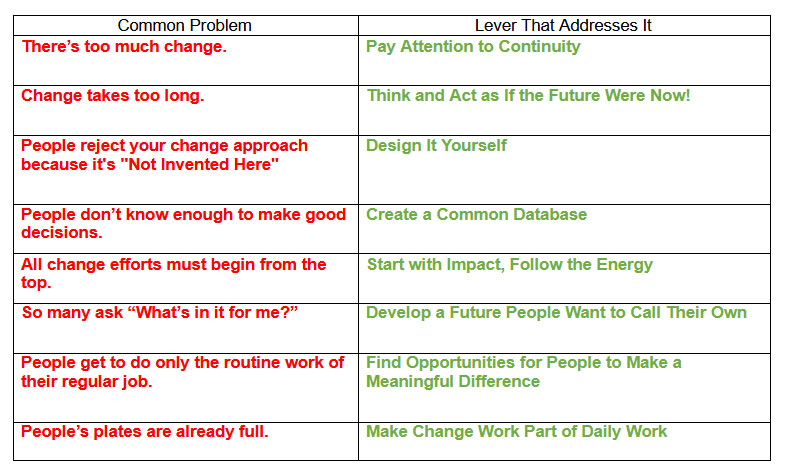Leverage Change: Transform Your Organization by Changing Your Paradigms

Transforming organizations takes years, is hard work, and often leads to disappointing results. This is common wisdom. It’s been proven time and again. It goes with the territory.
But it doesn’t have to be that way.
Most approaches to organization transformation are littered with flawed paradigms. Paradigms that inherently lead to these efforts falling short of the mark. Want different results? See the world in new ways.
Uncommon wisdom makes it possible to achieve faster, easier, better results with any transformation effort, in any organization, made by anyone. The approach I am describing is chockfull of new paradigms, fresh perspectives on problems that have plagued organizations for years.
Welcome to the world of Leverage Change.
Leverage Change: Leverage Change is a flexible approach to applying eight ways for individuals, teams and organizations to transform faster, easier, and better than you believe possible. You can use it to turbocharge a change method you’re already using or as the foundation for one you’re developing. It applies equally well to simple efforts involving a few people to complex ones engaging tens of thousands. Benefit from it as you launch a transformation effort and reap rewards if your work is already underway. Be the “go to” person when it comes to change, advancing your career and organization alike.
Adopt the paradigm of leverage and accomplish more with fewer hassles, headaches and problems. Archimedes, a third century B.C. Greek mathematician described the power of leverage when he said, “Give me a lever long enough, and a fulcrum on which to place it, and single-handed I shall move the world.” You can move your worlds in the arena of transformation by changing your paradigms about how it happens. Leverage Change is your guide map along this journey.
Leverage Change is comprised of eight levers, or smart, strategic actions, that yield profound results. Each addresses a common problem that prevents transformation efforts from succeeding (see Table 1.) While there are eight powerful ways available in creating effective transformations, I am going to focus on one that addresses a frequent frustration of leaders: change taking too long.
Organizations pay a steep price for slow transformation efforts, even when they can eventually claim victory from their work. While you are toiling away, competition is winning new markets, commercializing leading-edge technologies, making valuable process improvements, and creating cultures that lead to advantages in recruitment and retention of top talent.
Table 1
Common Problems with Transformation Work and Levers That Address Them
Living in a Leverage Change World
How can you reduce the time it takes to transform an organization from years to months? Embrace a new paradigm, the lever noted above of Thinking and Acting as if the Future Were Now! Instead of seeing the future as something “out there” that will occur at a later point in time, choose to live it today. Here. Now. When you and your entire organization make this shift, transformation occurs rapidly, even in some cases instantaneously.
Your old paradigm told you that transforming culture takes years. Plenty of experts will tell you the same. Don’t buy it. Your new culture will take years to create because you believe it will. If you want a more participative culture, think and act as if this close collaboration already exists. This paradigm shift immediately changes the game. In this new reality, who should be in the room for the meeting you’re in now? What criteria should you be using to make decisions today? How much power should different stakeholders hold in this moment? Stop talking about the future. Start living it.
Then encourage others to join you in this journey. Create an organization that subscribes to this new paradigm. Benefits of effective change work accrue to the bold. Colleagues previously reticent to jump aboard the transformation train see and hear change occurring all around them. Their belief that this time it’s for real increases significantly. As they begin thinking and acting as if the future were now, their colleagues’ faith in the future being real creates a virtuous cycle of ongoing transformation. At the same time, you’ll be collecting financial, quality, customer satisfaction and other “winnings” sooner…and being able to reinvest them, further stoking the engine of your transformation efforts.
A Transformation Challenge
You have a new strategy implementing end-to-end improvements in all your core processes. It’s smart, innovative and sure to give you a leg up on the competition…if you implement it before they make their next competitive move. But how do you get that job done well? And done now?
3 Steps to Jump Starting the Transformation of Your Organization
How does the lever Think and Act as if the Future Were Now! accelerate implementation of your new strategy? I outline how to do this, providing answers to the above implementation effort as examples. Pick your own transformation work – for yourself, your team or your organization – and respond to each of the steps for your own benefit.
Step 1: Describe the essential elements of the preferred future you aspire to create.
- New functional partnerships that support the end-to-end process improvement initiatives.
- Stakeholder agreements on measures of success for midstream and completed core processes.
- Cross-functional reports at Exec Committee meetings on core process performance (instead of the prior functional reports on independent objectives)
Step 2: If you were already living in this preferred future, how would you be thinking and what actions would you be taking right now?
- Convene a new “Collaborative Council” with cross-functional representatives that signs off on critical core process changes that impact their work
- Ask core process-oriented questions in each business unit meeting to prevent potential implementation issues instead of having to find and fix them downstream
- Begin cross-functional core process reports at next Exec Committee meeting as part of Implementation Launch of project (instead of after implementation is completed)
Step 3: Invite others to join you in Thinking and Acting as if the Future Were Now!
Introduce this new paradigm to the rest of the Executive Committee at our next meeting and list all the ways we can begin “living the future today” – both individually and collectively – immediately.
Paradigms help us make sense of our organizations. They can also get in the way. Change your paradigms. Transform your organization.
This article was adapted from the book Leverage Change: 8 Ways to Achieve Faster, Easier, Better Results by Jake Jacobs.
Bring the best of the CEOWORLD magazine's global journalism to audiences in the United States and around the world. - Add CEOWORLD magazine to your Google News feed.
Follow CEOWORLD magazine headlines on: Google News, LinkedIn, Twitter, and Facebook.
Copyright 2025 The CEOWORLD magazine. All rights reserved. This material (and any extract from it) must not be copied, redistributed or placed on any website, without CEOWORLD magazine' prior written consent. For media queries, please contact: info@ceoworld.biz









